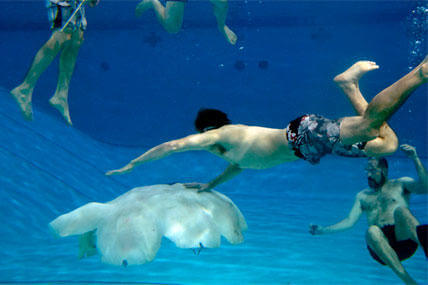A man-sized robot jellyfish is patrolling U.S. coasts.
A Virginia Tech College of Engineering team has announced their successful testing of this new jellyfish robot. Weighing in at 170 pounds, the robot prototype called Cyro, is far larger than its predecessor.
In 2012, the team led by Professor Shashank Priya revealed RoboJelly, approximately the size of a real jellyfish. In less than a year, they have evolved from the size of a human hand to nearly 6 feet in length.
Cyro is the product of nationwide research funded by U.S. Naval Undersea Warfare Center and the Office of Naval Research. The $5 million research program includes other universities as well such as University of California Los Angeles, the University of Texas at Dallas and Stanford University.
UCLA's research is developing underwater sensing and communication for the jellyfish robots based on electric fields. The goal is to create robots that are autonomous and self-powered to conduct surveillance. They could also be deployed to map ocean floors, study marine life and monitor the environment and ocean currents.
The larger the jellyfish robot, the more potential it has for greater endurance and operational range.
Jellyfish live in every ocean of the world, inhabiting both salt and fresh water, making it easier for a robot jellyfish to blend in and go undetected.
Cyro
Cyro has been built to replicate the jellyfish that also inspired its name, the cyanea capillata.
Compared to other marine life, jellyfish have a low metabolic rate and consume little energy, making them attractive as inspiration for robot design.
Researchers like those at the University of Gothenberg have been studying the North American comb jellyfish capable of silently approaching a target like a stealth submarine.
Different species of jellyfish inhabit a range from shallow coastal waters through to 4 or more miles below sea level and are capable of enduring an equally wide range of temperature.
The Nomura jellyfish can grow up to six feet long and weigh more than 600 pounds. With a thick layer of skin made of silicone that covers the "electronic guts," Cyro looks very much like a real jellyfish.
Cyro is autonomous and can swim by itself like a real jellyfish. In order to swim, the robot jellyfish has electric motors that direct its arms and artificial jelly body.
The robot jellyfish does not have a nervous system. To move and execute missions it uses "a diffused nerve net." While swimming, it can collect and analyze data at the same time. It can also relay the information back to humans.
The goal is for the robot jellyfish to operate for months on their own. Robojelly needed to be tethered to operate, but Cyro can run on its own powered by a rechargeable nickel metal hydride battery.
Next Phase
Both robots are in prototype phase and it will be several years before they could be deployed.
However, a new prototype model already is under construction and they're looking at reducing power consumption and improving its ability to swim.
Ballet dancer turned defense specialist Allison Barrie has traveled around the world covering the military, terrorism, weapons advancements and life on the front line. You can reach her at wargames@foxnews.com or follow her on Twitter @Allison_Barrie






























